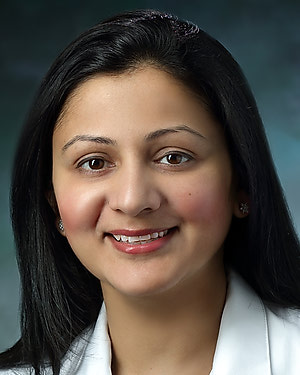Takeaway
There's and increasing risk of colon cancer in younger patients. Clinicians need to be diligent in considering the possibility of colon cancer.

Lifelong Learning in Clinical Excellence | February 19, 2024 | 2 min read
By Ekta Gupta, MBBS, Johns Hopkins Medicine
I’ve been a gastroenterologist for the last 14 years. I still remember a patient, a young 37-year-old, early on in my practice. She was the first patient in clinic for the day, dressed formally in a suit. She wanted to wrap up the office visit and rush to work, as she had an important business meeting. She made it clear that her mother made the appointment for her, as her mother knew she would never make the appointment for herself, as was just too busy.
She reported noticing blood in stool for almost a year and she was sure it was hemorrhoids. There was no family history of colon cancer or weight loss. She had been mildly anemic on her labs with her primary care recently, but she disclosed her periods had been heavy too. I asked about her physical activity and we connected over a shared loved Peloton bike riding, but the rectal bleeding was impacting that too. I suggested a colonoscopy and scheduled her for the following week.
She was the first patient of the day again and we inserted the colonoscope. The first thing I noted was a raw friable semi circumferential mass in the rectum; not something I was expecting. She could read the concern in my eyes. I apologized for being bearer of bad news. She was attentive to details and focused on next steps. I referred her to the rectal cancer multidisciplinary clinic that had a radiologist, oncologist, and colorectal surgeons, and a streamlined management strategy, including disease staging with a MRI, freezing her eggs given her young age. Six months later I saw her for a surveillance flexible sigmoidoscopy, and all was normal.
According to a 2024 report from the American Cancer Society (ACS), colorectal cancer has moved up from being the fourth leading cause of cancer death in both men and women under age 50 two decades ago, to first in men and second in women. (Breast cancer is the leading cause of death in women under 50.)
It is important to recognize symptoms suggestive of colon cancer early on; take notice of the following:
1. Any change in bowel pattern.
2. A new onset of diarrhea or constipation.
3. A change in stool, especially thinner or ribbon-like, which is due to the tumor causing obstruction.
4. Rectal bleeding, even if the patient thinks it’s a hemorrhoid.
5. New onset anemia that can’t be explained by any other cause.
Two reasons for the uptick in colon cancer in young people includes a reliance on frozen meals high in preservatives and a sedentary lifestyle that may result in obesity,
Besides colonoscopy there are validated non-invasive testing methods:
1. Stool fecal immunochemical testing.
2. Stool DNA testing if there’s no family history of colon cancer, colon polyps, or inflammatory bowel disease.
3. Virtual colonoscopy.
4. Consider colonoscopy 10 years earlier than the family member who was diagnosed with colon cancer.
Discuss with patients how to make changes in their daily lives for prevention:
1. Avoid smoking.
2. Minimize alcohol consumption.
3. Increase fiber intake.
4. Be physically active to prevent obesity.
5. Minimize red meat consumption.
My young patient became an advocate for awareness for colon cancer. She organized community events, invited nutritionists to schools, and initiated a local movement encouraging healthier habits. Her story inspired others to prioritize nutrisous foods and regular exercise.
This piece expresses the views solely of the author. It does not necessarily represent the views of any organization, including Johns Hopkins Medicine.

